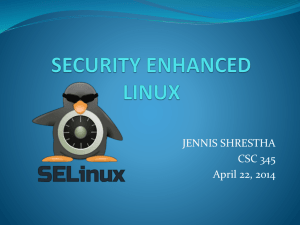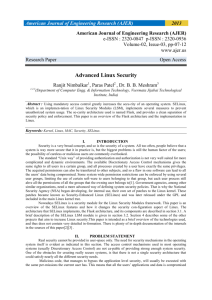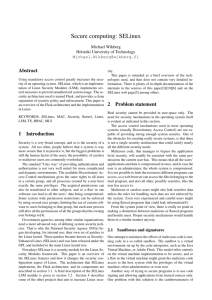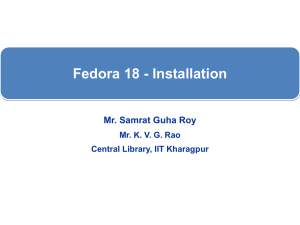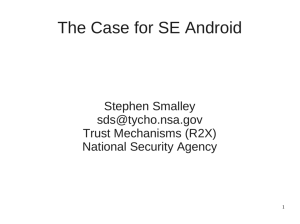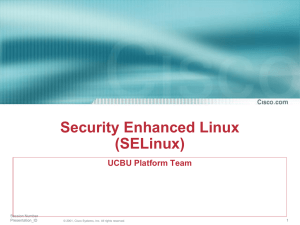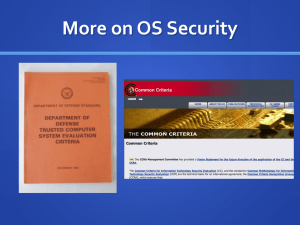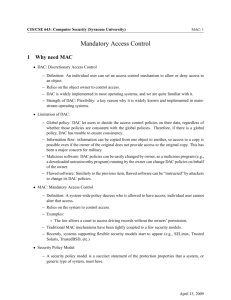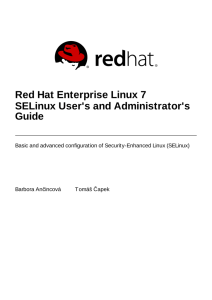SELinux for Mere Mortals.
advertisement
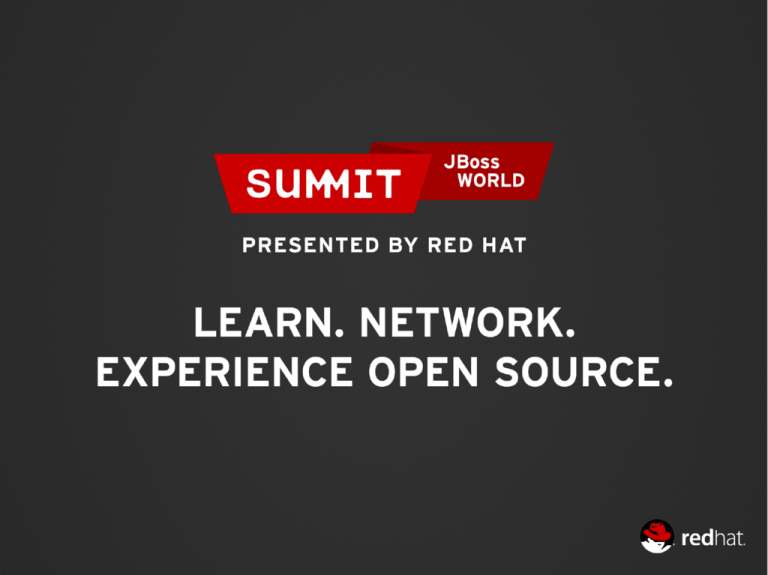
SELINUX FOR MERE MORTALS Thomas Cameron, Chief Architect, Red Hat 06.27.12 RHCA, RHCSS, RHCDS, RHCVA, RHCX Agenda ● About Us ● What is SELinux? ● ● Where did it come from? ● DAC vs. MAC So How Does SELinux Work? ● Labeling and Type Enforcement ● How Do I Deal With Labels? ● Real World Examples Contact Info ● thomas@redhat.com ● thomasdcameron on Twitter ● choirboy on #rhel on Freenode ● http://people.redhat.com/tcameron ● http://excogitat.us ● thomas.cameron on Google talk About Us ● ● ● Red Hat leads the way in SELinux development. John Dennis, Ulrich Drepper, Steve Grubb, Eric Paris, Roland McGrath, James Morris and Dan Walsh, all Red Hat staffers, acknowledged by the NSA for their contributions to SELinux at: http://www.nsa.gov/research/selinux/contrib.shtml Red Hat acknowledged by the NSA as a corporate contributor as well. What is SELinux? ● Where did it come from? ● ● ● Created by the United States National Security Agency (NSA) as set of patches to the Linux kernel using Linux Security Modules (LSM) Released by the NSA under the GNU General Public License (GPL) in 2000 Adopted by the upstream Linux kernel in 2003 What Thomas thought SELinux was If you feel the same way... If you feel the same way... ● You're in the right place! What is SELinux? What is SELinux? ● SELinux is an example of a Mandatory Access Control system for Linux. DAC vs. MAC ● Historically, Linux and Unix systems have used discretionary access control. ● ● Ownership (user, group, and other) plus permissions. Users have the ability (discretion) to change permissions on their own files. A user can chmod +rwx his or her home directory, and nothing will stop them. Nothing will prevent other users or processes from accessing the contents of his home directory. DAC vs. MAC ● Historically, Linux and Unix systems have had discretionary access control. ● The root user is omnipotent. DAC vs. MAC ● ● On a mandatory access control system, there is policy which is administratively set and fixed. Even if you change the DAC settings on your home directory, if there is a policy in place which prevents another user or process from accessing it, you're generally safe. DAC vs. MAC ● These policies can be very fine grained. Policies can be set to determine access between: ● Users ● Files ● Directories ● Memory ● Sockets ● tcp/udp ports ● etc... Policy ● In Red Hat Enterprise Linux 6, there are two policies you'll generally see. ● “targeted” - the default policy ● ● ● Only targeted processes (there are hundreds) are protected by SELinux Everything else is unconfined “mls” - multi-level/multi-category security ● Out of scope for today's presentation ● Can be very complex ● Typically used in TLA government organizations So How Does SELinux Work? ● You can determine what policy your system is set to use by looking at /etc/selinux/config (which is also symlinked to /etc/sysconfig/selinux) ● You can check via /usr/sbin/sestatus ● You can also check via /usr/sbin/getenforce So How Does SELinux Work? ● Two of the important concepts to understand with SELinux are: ● Labeling ● Type Enforcement So How Does SELinux Work? ● Labeling ● ● ● Files, processes, ports, etc., are all labeled with an SELinux context. For files and directories, these labels are stored as extended attributes on the filesystem. For processes, ports, etc., the kernel manages these labels. So How Does SELinux Work? ● Labeling ● Labels are in the format: ● ● ● user:role:type:level(optional) For the purpose of this presentation, we will not deal with the SELinux user, role or level. These are used in more advanced implementations of SELinux (MLS/MCS). What we really care about for today's presentation is the type (remember, labeling and type enforcement). So How Does SELinux Work? ● ● We'll look at a fairly complex service, one which provides access from the network, potentially on several ports, and potentially, access to the whole filesystem. The Apache web server is not necessarily insecure, it is just very wide ranging in its access. So How Does SELinux Work? ● The Apache web server has a binary executable which launches from /usr/sbin. When you look at that file's SELinux context, you see its type is httpd_exec_t: So How Does SELinux Work? ● The web server's configuration directory is labeled httpd_config_t: So How Does SELinux Work? ● The web server's logfile directory is labeled httpd_log_t: So How Does SELinux Work? ● The web server's content directory is labeled httpd_sys_content_t: So How Does SELinux Work? ● The web server's startup script is labeled httpd_initrc_exec_t: So How Does SELinux Work? ● As the web server runs, it's process is labeled httpd_t: So How Does SELinux Work? ● If you look at the ports upon which the web server listens, you'll see that even they are labeled. So How Does SELinux Work? ● Now then... The /etc/shadow file has a type shadow_t: So How Does SELinux Work? ● Type enforcement So How Does SELinux Work? ● Type enforcement ● It probably makes sense for a process running in the httpd_t context to interact with a file with the httpd_config_t label. So How Does SELinux Work? ● Type enforcement ● Do you think it makes sense for a process running with the httpd_t context label to be able to interact with a file with, say, the shadow_t label? So How Does SELinux Work? ● Type enforcement ● Type enforcement is the part of the policy that says, for instance, “a process running with the label httpd_t can have read access to a file labeled httpd_config_t” How Do I Deal With Labels? How Do I Deal With Labels? ● You've seen me use the -Z argument to several commands to view context. Many commands accept this argument: ● ls -Z ● id -Z ● ps -Z ● netstat -Z How Do I Deal With Labels? ● You can actually use the -Z argument to create and modify files and contexts, as well. ● cp -Z ● mkdir -Z How Do I Deal With Labels? ● ● ● ● You can use SELinux aware tools like chcon or restorecon to change the context of a file (more on this later). Contexts are set when files are created, based on their parent directory's context (with a few exceptions). RPMs can set contexts as part of installation. The login process sets the default context (unconfined in the targeted policy) How Do I Deal With Labels? ● File transitions (defined by policy) ● ● If an application foo_t creates a file in a directory labeled bar_t, policy can require a transition so that file is created with the baz_t label. Example: A process, dhclient, running with the dhclient_t label creates a file, resolv.conf, labeled net_conf_t in a directory, /etc, labeled etc_t. Without that transition, /etc/resolv.conf would have inherited the etc_t label. How Do I Deal With Labels? ● You've also seen me use the semanage command. It can be used to manage SELinux settings for: ● login ● user ● port ● interface ● module How Do I Deal With Labels? ● You've also seen me use the semanage command. It can be used to manage SELinux settings for: ● node ● file context ● boolean ● permissive state ● dontaudit What Does It Mean If I Get An SELinux Error? What Does It Mean If I Get An SELinux Error? ● ● If you see an SELinux error, it means that something is wrong! Turning off SELinux is like turning up the radio really loud when your car is making a strange noise! What Does It Mean If I Get An SELinux Error? ● It may mean that labeling is wrong ● Use the tools to fix the labels. We'll talk more about that later. What Does It Mean If I Get An SELinux Error? ● It may mean that the policy needs to be tweaked. ● booleans ● Policy modules What Does It Mean If I Get An SELinux Error? ● There could be a bug in the policy ● We need to know about these! Open a ticket (do not file a Bugzilla report - there are no SLAs around BZ). What Does It Mean If I Get An SELinux Error? ● You have been, or are being, broken into ● Man the battle stations! What Are Booleans? ● Booleans are just off/on settings for SELinux. ● From simple stuff like “do we allow the ftp server access to home directories” to more esoteric stuff like “httpd can use mod_auth_ntlm_winbind.” What Are Booleans? ● To see all the booleans, run getsebool -a What Are Booleans? ● ● To set a boolean, run setsebool [boolean] [0|1] To make it permanent, pass the -P argument to setsebool Tips and Tricks ● ● Install setroubleshoot and setroubleshoot-server on machines you'll be developing policy modules on. They drag in a bunch of tools to help diagnose and fix SELinux issues. Reboot or restart auditd after you install. Real World Examples Real World Examples ● A user, fred, wants to have his own web page in /home/fred/public_html on a web server. ● You enable UserDir in /etc/httpd/conf/httpd.conf ● Restart the web server Real World Examples ● A user, fred, wants to start have his own web page in /home/fred/public_html ● Change permissions so the web server can access his home directory. Real World Examples ● A user, fred, wants to start have his own web page in /home/fred/public_html ● Fred logs in, creates his public_html directory and an index.html file. Real World Examples ● A user, fred, wants to start have his own web page in /home/fred/public_html ● We fire up the web browser, and: Real World Examples ● A user, fred, wants to start have his own web page in /home/fred/public_html ● So now we check the usual suspects. ● /var/log/httpd/access_log ● /var/log/httpd/error_log Real World Examples ● A user, fred, wants to start have his own web page in /home/fred/public_html ● We already knew that! Real World Examples ● A user, fred, wants to start have his own web page in /home/fred/public_html ● So now we look at /var/log/messages Real World Examples ● A user, fred, wants to start have his own web page in /home/fred/public_html ● ● AH-HAH! Follow the instructions and run “sealert -l 9f88e0bb-5f4b-4e3a-96b2-7644917fbfc4” It reveals that there are two issues. ● User content ● httpd access to home directories Real World Examples ● A user, fred, wants to start have his own web page in /home/fred/public_html ● It also says we can create a policy module to allow this, but in this case, setting a boolean is easier and makes more sense. Real World Examples ● A user, fred, wants to start have his own web page in /home/fred/public_html ● Follow the instructions and set the two booleans. Real World Examples ● A user, fred, wants to start have his own web page in /home/fred/public_html ● And... Voila! Real World Examples ● And people say this SELinux thing is too hard! Pffft! How Can I See What Booleans Have Been Set? How Can I See What Booleans Have Been Set? ● Look at the booleans.local file under /etc/selinux/targeted/modules/active/ How Can I See What Booleans Have Been Set? ● Note that when you use setsebool -P (and other commands we'll cover later), the entire /etc/selinux/targeted directory is regenerated. That file doesn't actually do anything - it just tells you what's been set. Believe it when it says “Do not edit directly” it won't do anything. Real World Examples ● This next example assumes an unmodified SELinux environment, so ignore the changes from the last example. Real World Examples ● A user, Wilma, is a web content author. She has created content in her home directory and asked that you move it to the web site. Real World Examples ● So, you move it over. Real World Examples ● And when you go to test... Real World Examples ● Ah, it's the wrong owner, right? Real World Examples ● But when you test... Real World Examples ● Checking /var/log/messages again tells you to run sealert. Real World Examples ● But this time, sealert is still talking about user content and home directories... We're dealing with content in the system web content directory, /var/www/html. Real World Examples ● A quick ls -Z reveals the issue. Real World Examples ● ● We moved instead of copied, so the file kept its original context. To change the context, we can run one of a couple of commands. Real World Examples ● First we need to figure out what the label should be. Look at a known good file label. Real World Examples ● ● Use that information as arguments for the chcon (change context) command The long form is: Real World Examples ● Remember that the targeted policy doesn't use the SELinux user or role. The short form is: Real World Examples ● I'm lazy. If I just want to reference a known good context, the shortest form is: Real World Examples ● If you just want to restore a directory and all its files to the default context, the easiest to remember is restorecon: Where Are These Contexts Stored? ● ● restorecon uses information from /etc/selinux/targeted/contexts/files/file_contexts (and other files in that directory) to determine what a file or directory's context should be. There are over 4000 entries in this file. Don't modify this file directly, your changes will be lost! Real World Examples Real World Examples ● Someone tells you to create a web directory somewhere non-standard - /foo/bar - for a virtual web site. Real World Examples ● You create the directory: Real World Examples ● You define the virtual web site in httpd.conf: Real World Examples ● You create an index.html file: Real World Examples ● Restart the web server: Real World Examples ● When you test the page... Real World Examples ● What logfile should we check? Real World Examples ● /var/log/messages Real World Examples ● Note that at the end it tells you to restorecon! Real World Examples ● What directory should we look at to get the correct context label? Real World Examples ● We actually want all of the files under /foo to have the right context, so we'll use a regular expression (you can get the syntax from /etc/selinux/targeted/contexts/files/file_contexts): Real World Examples ● Or, if you're like me (lazy), you can use the -e (equals) argument to semanage fcontext: Real World Examples ● Now run restorecon against the directory: Real World Examples ● Test the site: Creating Policy Modules Creating Policy Modules ● In the case that a boolean or labeling does not fix your issue, you might have to create a policy module. Creating Policy Modules ● In this example, I want to install squirrelmail on a RHEL 6.3 mail server. Creating Policy Modules ● ● Now that I know there is an SELinux issue, I set SELinux enforcement to “permissive” and then run the application through all its paces. In this case, sending and receiving mail. This will log denials but not act on them. If you don't do this, you'll fix one, trigger a second, fix the second, trigger a third, etc. It's easier to run the app in permissive mode and catch all of them. Note ● Actually, this error could be fixed by setting a boolean. I am just creating a policy module so you can see it being done. Enabling SELinux Enabling SELinux ● ● To enable SELinux on a system, edit /etc/selinux/config and set SELINUX=permissive Do not set it to enforcing, as it will more than likely hang at boot time. Enabling SELinux ● Then create a file in the root of the filesystem called .autorelabel Enabling SELinux ● Reboot, and the system will relabel the filesystem. Enabling SELinux ● You can also run fixfiles relabel. ● ● Don't do it in runlevel 5 - it deletes everything in /tmp and your X font server will get real cranky about that. Reboot after it's done. Enabling SELinux ● After everything is relabeled, then set it to enforcing in /etc/selinux/config and reboot or run setenforce 1. Graphical Tools Graphical Tools ● This stuff is so easy, even a Windows admin can do it! ● Install xorg-x11-xauth, a font (I like bitmap-fixed-fonts, or you can do yum groupinstall fonts), and policycoreutilsgui. and you can ssh -X into the box and run systemconfig-selinux And That's It! ● Hopefully, you now feel like: Final Thoughts ● Don't turn it off! ● SELinux can really save you in the event of a breach. ● ● It's much easier to use SELinux today than it was just a few months ago NSA grade security is available at no extra cost - use it! Thank You! ● If you liked today's presentation, please let us know! More Information ● ● ● SELinux Guide: http://docs.redhat.com/docs/enUS/Red_Hat_Enterprise_Linux/6/html/SecurityEnhanced_Linux/index.html Fedora Project SELinux Docs: http://fedoraproject.org/wiki/SELinux fedora-selinux-list (mailing list): ● ● https://www.redhat.com/mailman/listinfo Red Hat Training - Red Hat Enterprise SELinux Policy Administration: http://www.redhat.com/training More Information ● ● http://access.redhat.com has several videos about SELinux. Dave Egts and Dan Walsh have covered topics from confining users to sandboxing. Dan Walsh's blog: ● http://danwalsh.livejournal.com/ Questions?
